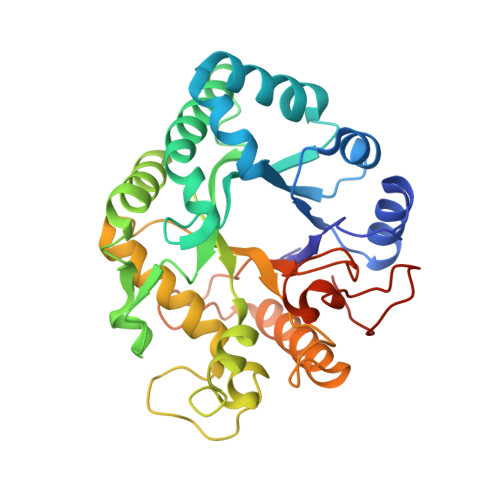Structures of an active-site mutant of a plant 1,3-beta-glucanase in complex with oligosaccharide products of hydrolysis
Wojtkowiak, A., Witek, K., Hennig, J., Jaskolski, M.(2013) Acta Crystallogr D Biol Crystallogr 69: 52-62
- PubMed: 23275163
- DOI: https://doi.org/10.1107/S0907444912042175
- Primary Citation of Related Structures:
4GZI, 4GZJ - PubMed Abstract:
Plant endo-1,3-β-glucanases are involved in important physiological processes such as defence mechanisms, cell division and flowering. They hydrolyze (1→3)-β-glucans, with very limited activity towards mixed (1→3,1→4)-β-glucans and branched (1→3,1→6)-β-glucans. Here, crystal structures of the potato (Solanum tuberosum) endo-1,3-β-glucanase GLUB20-2 with the nucleophilic Glu259 residue substituted by alanine (E259A) are reported. Despite this active-site mutation, the protein retained residual endoglucanase activity and when incubated in the crystallization buffer with a linear hexameric substrate derived from (1→3)-β-glucan (laminarahexose) cleaved it in two different ways, generating trisaccharides and tetrasaccharides, as confirmed by mass spectrometry. The trisaccharide (laminaratriose) shows higher binding affinity and was found to fully occupy the -1, -2 and -3 sites of the active-site cleft, even at a low molar excess of the substrate. At elevated substrate concentration the tetrasaccharide molecule (laminaratetrose) also occupies the active site, spanning the opposite sites +1, +2, +3 and +4 of the cleft. These are the first crystal structures of a plant glycoside hydrolase family 17 (GH17) member to reveal the protein-saccharide interactions and were determined at resolutions of 1.68 and 1.55 Å, respectively. The geometry of the active-site cleft clearly precludes any (1→4)-β-glucan topology at the subsites from -3 to +4 and could possibly accommodate β-1,6-branching only at subsites +1 and +2. The glucose units at subsites -1 and -2 interact with highly conserved protein residues. In contrast, subsites -3, +3 and +4 are variable, suggesting that the mode of glucose binding at these sites may vary between different plant endo-1,3-β-glucanases. Low substrate affinity is observed at subsites +1 and +2, as manifested by disorder of the glycosyl units there.
Organizational Affiliation:
Department of Crystallography, Faculty of Chemistry, A. Mickiewicz University, Poznan, Poland.

















